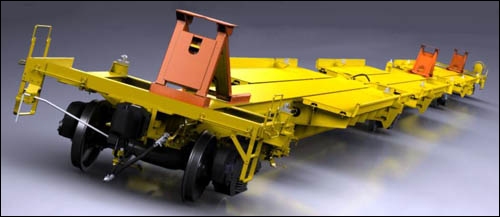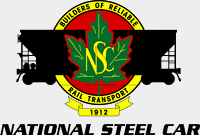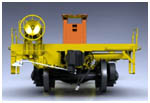Vol. 18 No. 11
December 1988/January 1989
|
Safety - Priority #1
|
Spine Cars to Bolster Container Service
By Len Cocolicchio

National Steel Car
built spine car - all photos by National Steel Car.
 CP Rail is introducing a new type of multi-container
car that goes longer, rather than higher, for more capacity and smoother ride. CP Rail is introducing a new type of multi-container
car that goes longer, rather than higher, for more capacity and smoother ride.
It's called an articulated "spine car" and CP Rail will lease 100 of them from CGTX Inc., and Alberta
Intermodal Services.
Each car is a five-platform set that, viewed vertically, resembles a spine. Each platform can carry two
20-foot containers, one 40-foot container, or a 48-foot container.
  
  
GREATER CAPACITY
The railway is turning to the spine car in response to growing demand from shippers for service, like
double-stack, that reduces the jarring slack action in couplers during transport. The platforms on
most double-stack cars are linked by articulated connections that eliminate slack action.
Demand for double-stacking has been growing particularly from shippers in the Pacific Rim. They export
mainly manufactured goods, including auto parts, which are often lightweight and sensitive. The spine car is
expected to help the railway compete against double-stack for a bigger slice of the growing Pacific
Rim traffic.
The car, designed and built by National Steel Car, of Hamilton, Ontario, has five articulated platforms. There is
an axle with a coupler at each end of the car and four shared axles in between to support the platforms and allow
them to swivel.
The shared axles eliminate the slack action, producing a smoother ride and reducing the potential for product damage
in transit. The spine car is also lighter than the equivalent number of conventional cars required to carry the same
container load. That means improved payload-to-tare weight and reduction in fuel costs.
FLEXIBILITY
The spine car provides more flexibility in the mix of container sizes than does the double-stack car.
And the car's platforms have been designed to provide the option of carrying two 20-foot units because
of the strong demand for this size container in Canada.
Each spine car is equivalent in carrying capacity to two-and-a-half 80-foot container
flatcars - so 100 spine cars can do the work of 250 cars.
The cars are expected to go into service for import-export traffic between Vancouver and
Toronto/Montreal in the first quarter of 1989.
This CP Rail News article is copyright
1989 by the Canadian Pacific Railway and is reprinted here
with their permission. All photographs, logos, and trademarks are the property of the Canadian Pacific Railway
Company.
|
|